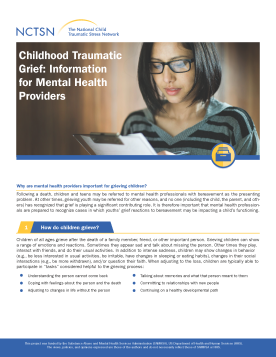
Childhood Traumatic Grief: Information for Mental Health Providers
Offers information on why mental health providers are important for grieving children. This fact sheet outlines how children grieve, what Childhood Traumatic Grief is...
Wildfires are fires that spread rapidly and rage out of control in areas of woodland, brushland, grassland, scrubland, peatland, and other wooded areas. Wildfires differ from other fires based on their larger size, how quickly they can spread from the original source, the potential to change direction unexpectedly, and their ability to jump gaps (e.g. roads, rivers, and fire breaks). Periodic fires can be beneficial to the ecosystem as they can reduce dead plants or an overabundance of live plants, reduce the number of damaging insets, recycle nutrients to the soil, and encourage plant growth. However, they can also cause massive damage to land, wildlife, homes, businesses, and schools. They generate lots of smoke and ash that create additional safety concerns, limiting outside activities, exacerbating medical conditions, or worsening respiratory issues. Wildfires are most common during the summer and fall when weather is dry, as well as during droughts. They commonly start and spread on “red-flag days” when it is windy, hot, and dry. Wildfire-damaged communities can be at increased risk for flooding and mudslides during heavy rains, which may create additional stress in the weeks, months, and years following the event.
Being prepared beforehand is the best way to help children and family members recover after a wildfire. To improve their preparedness, families should:
Knowing what to do during a wildfire can help families feel more in control and take steps to increase their safety. Consider the following:
During a wildfire but when not in an evacuation zone, families should:
During an evacuation, families should:
Immediately after a wildfire is contained, families should:
To address children’s reactions during a wildfire, parents and caregivers can:
After a wildfire, most families will recover over time, particularly with the support of family, friends, and organizations. The length of recovery depends, in part, on if they had to evacuate and how much time they had to respond, and the extent of the damage and loss in the community. Some families will be able to return to their normal routines rather quickly, while others will have to contend with loss and damage to their home and possessions, finding new housing, and financial hardship. Some families live in areas where they will have additional risks of floods or mudslides during the rainy season which will create additional anxiety and worry.
Children will react differently to wildfires depending on their age, developmental level, and prior experiences. Children may be very concerned about safety, and worry that another wildfire may occur. They may also get reminded when they see any type of fire (campfires, barbeques, fire in a fireplace), smell smoke or see ash, experience windy days or warm dry weather, or watch holiday fireworks. Children may also exhibit changes in their behavior, such as clinging to parents or caregivers, experiencing more headaches and stomachaches, performing poorly at school, or withdrawing from activities they used to enjoy.
Children’s functioning and recovery will be influenced by how their parents and caregivers cope after the wildfire and the behaviors they model. Children often turn to adults for information, comfort, and help. Parents and caregivers should:
In response to the recent wildfires in Maui, and across the US, the National Child Traumatic Stress Network has developed resources to help children, families, and communities navigate what they are seeing and hearing, acknowledge their feelings, and find ways to cope together.

Offers information on why mental health providers are important for grieving children. This fact sheet outlines how children grieve, what Childhood Traumatic Grief is...
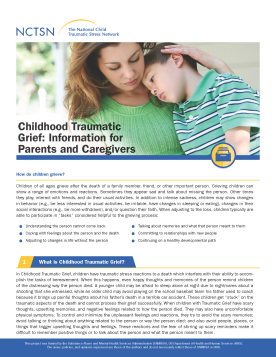
Provides information to parents and caregivers on Childhood Traumatic Grief.
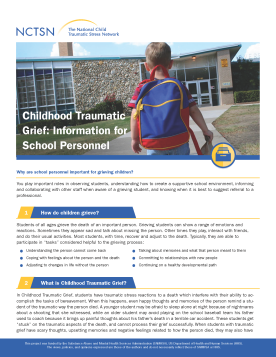
Offers information on why school personnel are important for grieving students. This fact sheet outlines how children grieve, what Childhood Traumatic Grief is, who develops Childhood Traumatic Grief, what traumatic stress reactions in Childhood Traumatic Grief can look like, the signs a student
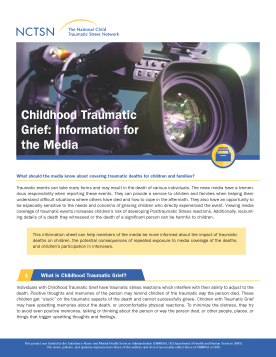
Provides information to the media on what to know about covering traumatic deaths for children and families.
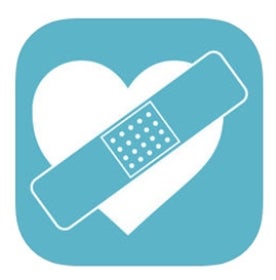
Helps parents talk to their kids about the disasters they may face and know how best to support them throughout—whether sheltering-in-place at home, evacuating to a designated shelter, or helping your family heal after reuniting.
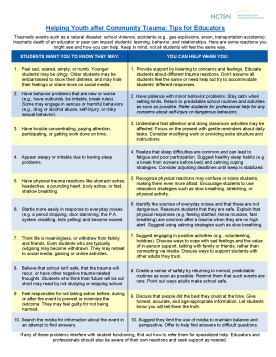
Lists common reactions educators might see in the students with whom they work and suggestions on how they may help after community trauma.
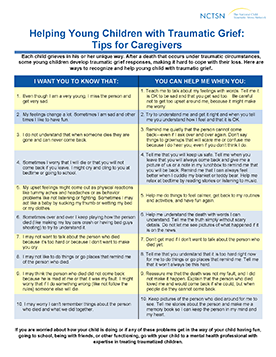
Outlines the feelings of young children struggling with the death of someone meaningful and offers suggestions on what caregivers can do to help.
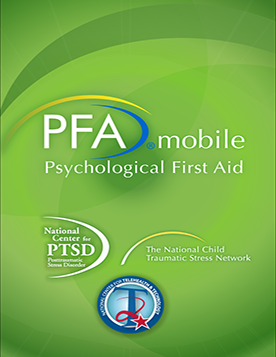
Lets responders review PFA guidelines and assess their readiness to deliver PFA in the field.
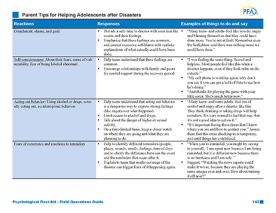
Is a handout from Psychological First Aid Field Operations Guide (PFA). This handout provides parents with common reactions after a disaster, ways to respond to those reactions, and examples of things you can say to your adolescent.

Is a handout from Psychological First Aid Field Operations Guide (PFA). This handout provides parents with common reactions after a disaster, ways to respond to those reactions, and examples of things you can say to your infants or toddlers.
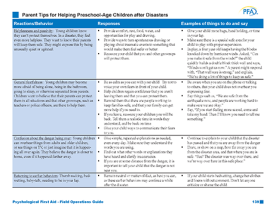
Is a handout from Psychological First Aid Field Operations Guide (PFA). This handout provides parents with common reactions after a disaster, ways to respond to those reactions, and examples of things you can say to your preschool-age child.
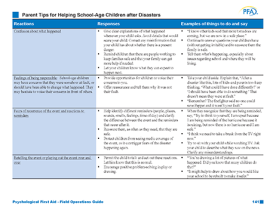
Is a handout from Psychological First Aid Field Operations Guide (PFA). This handout provides parents with common reactions after a disaster, ways to respond to those reactions, and examples of things you can say to your school-age child.